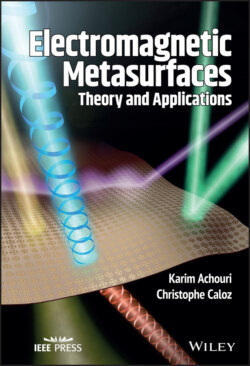Читать книгу Electromagnetic Metasurfaces - Christophe Caloz - Страница 20
2.6 Energy Conservation in Lossless–Gainless Systems
ОглавлениеFrom a practical perspective, it is often desirable to implement gainless and lossless systems. This specification requires certain conditions to be satisfied, which may be expressed either in terms of susceptibilities or scattering parameters. We shall next derive and discuss these conditions.
The conditions in terms of the susceptibilities may be directly deduced from the Poynting theorem. As shown in Section 2.5, a medium is gainless and lossless if Eq. (2.76) is zero for any field value, which implies that
(2.77)
Since these conditions are similar to the reciprocity conditions (2.51), it is interesting to see under which circumstances a medium satisfies (2.77) while being either reciprocal or nonreciprocal. For this purpose, Table 2.2 compares the different possible cases.
This table reveals that a gainless, lossless, and reciprocal medium has purely real electric and magnetic susceptibility tensors and purely imaginary magnetoelectric susceptibilities. Interestingly, we also see that it is possible for a medium to be gainless, lossless, and nonreciprocal.
We now express the corresponding relationships in terms of scattering parameters. For this purpose, consider a uniform bianisotropic slab sandwiched between two different media and illuminated by the normally incident waves and and scattering the waves and , where represents the electric field amplitude of the waves, as depicted in Figure 2.4. Here, we assume that the waves are all identically polarized.
The quantities are connected to each other via scattering parameters, , as
(2.78)
Table 2.2 Conditions for a medium to be gainless and lossless in addition to being either reciprocal or nonreciprocal.
| and | |||
|---|---|---|---|
| Reciprocal | |||
| Nonreciprocal |
Figure 2.4 Normal scattering by a bianisotropic slab sandwiched between two media.
Since the slab is gainless and lossless, conservation of power requires that the scattered power equals the incident power, i.e.
(2.79)
where and are the impedances of medium 1 and 2, respectively, and are assumed to be real quantities. Substituting (2.78) into (2.79), and considering that , yields
(2.80)
Since this equality holds for any field value, all the terms in brackets must vanish. We have thus
(2.81)
which indicates how the incident power distributes in terms of the reflected and transmitted power, and
(2.82)
which implies that the phases of the scattered waves are related to each other.
For a reciprocal slab with the same media at both sides, i.e. , these expressions reduce to
(2.83)
and
(2.84)
where by reciprocity. Interestingly, if the slab is gainless, lossless, reciprocal, and isotropic, as for instance a thin beam splitting blade, then and (Eq. 2.84) tells us that the argument of must necessarily be in quadrature with respect to .
